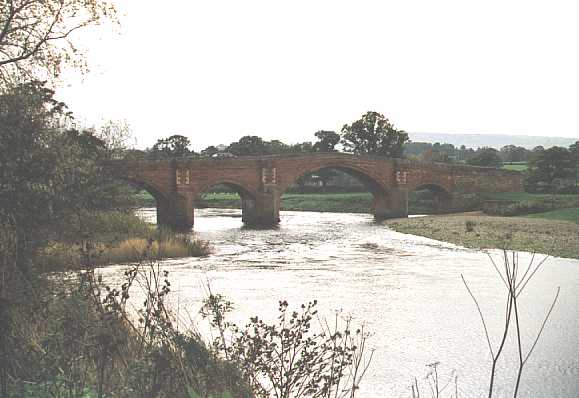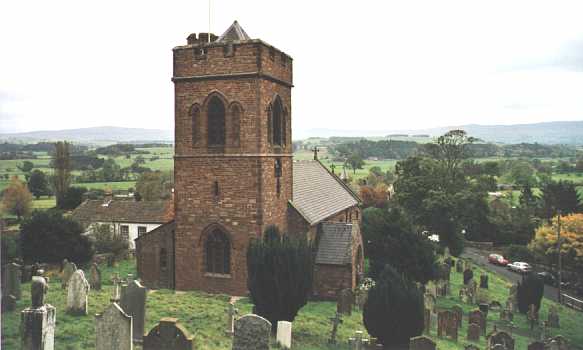 Contains the two townships of Lazonby and Plumpton Wall,
and extends about five miles in length from N. to S., and three in breadth from E. to W.
It is bounded on the S. by Great Salkeld, on the S.W. by Penrith and Hutton, on the N. and
W. by Hesket, and on the E. and N.E. by the river Eden. The west side of the parish is
washed by the Petteril, and in its centre is a range of healthy moorlands and fells, the
northern part of which is covered by a large forest of oaks, &c. called Baron Wood,
and belongs to Sir George Musgrave, Bart. The arable land lies in the vale of the Eden and
Petteril, and near the great road from Carlisle to Penrith. The soil in some parts is
composed of a rich loam, and in other parts it is of a gravelly nature; and here is an
excellent free stone quarry, and another where barley mill stones are made.
The parish contains 9600 acres, and 891 inhabitants. Besides the great Roman road,
which extended from north to south, another intersects the parish at Salkeld gate; and in
Plumpton Wall township is the station of Old Penrith, about five miles north-west
of the town of Penrith. This is the Bremetenracum1 of the
Romans, and had a military way, twenty-one feet broad, leading from it to the wall. The
site of this station comprised an area of about three acres, and traces of its foundations
and outbuildings are still observable. The Cuneus Armaturarum, a troop of horse
armed in the most complete manner, was in garrison here. Several urns, containing bones
and ashes, were found about seventy years ago upon the fell; and Hutchinson says there
were several cairns on the commons, and that at a place called Castle Rigg, were the ruins
of a building, moated round. In Baron Wood, there is a large rock, in which is a cave,
apparently artificial, called the Giant's Chamber, and sometimes Sampson's Cave. The
commons were enclosed under the act of 1803, for the enclosing of Inglewood Forest; and
the principal land owners of the parish are Sir George Musgrave, Bart., and colonel
M'Lean.
Contains the two townships of Lazonby and Plumpton Wall,
and extends about five miles in length from N. to S., and three in breadth from E. to W.
It is bounded on the S. by Great Salkeld, on the S.W. by Penrith and Hutton, on the N. and
W. by Hesket, and on the E. and N.E. by the river Eden. The west side of the parish is
washed by the Petteril, and in its centre is a range of healthy moorlands and fells, the
northern part of which is covered by a large forest of oaks, &c. called Baron Wood,
and belongs to Sir George Musgrave, Bart. The arable land lies in the vale of the Eden and
Petteril, and near the great road from Carlisle to Penrith. The soil in some parts is
composed of a rich loam, and in other parts it is of a gravelly nature; and here is an
excellent free stone quarry, and another where barley mill stones are made.
The parish contains 9600 acres, and 891 inhabitants. Besides the great Roman road,
which extended from north to south, another intersects the parish at Salkeld gate; and in
Plumpton Wall township is the station of Old Penrith, about five miles north-west
of the town of Penrith. This is the Bremetenracum1 of the
Romans, and had a military way, twenty-one feet broad, leading from it to the wall. The
site of this station comprised an area of about three acres, and traces of its foundations
and outbuildings are still observable. The Cuneus Armaturarum, a troop of horse
armed in the most complete manner, was in garrison here. Several urns, containing bones
and ashes, were found about seventy years ago upon the fell; and Hutchinson says there
were several cairns on the commons, and that at a place called Castle Rigg, were the ruins
of a building, moated round. In Baron Wood, there is a large rock, in which is a cave,
apparently artificial, called the Giant's Chamber, and sometimes Sampson's Cave. The
commons were enclosed under the act of 1803, for the enclosing of Inglewood Forest; and
the principal land owners of the parish are Sir George Musgrave, Bart., and colonel
M'Lean. Lazonby village is on the west side of the vale of Eden, one mile
S.W. of Kirkoswald, and seven miles N. by E. of Penrith. The Church, which is
dedicated to Saint Nicholas, was given in 1272, by Sir Hugh Morvill, to the priory of
Lanercost. At the dissolution of the priory, the rectory was granted by Edward VI, or
rather his responsible advisers, to Sir Thomas Dacre, Knight, whose descendant sold it to
John Barwick, dean of St. Paul's, who bequeathed it to the chapel and poor of Witherslack,
in Westmorland, reserving only £2 a year for the vicar of Lazonby. The Vicarage is
valued in the king's books at £13 1s. 2d. The bishop of Carlisle is the patron, and the
Revd. John Heysham is the incumbent. The tithes of Lazonby township have been commuted for
a yearly modus of £455, viz., rectorial, £208, and vicarial, £247; and of Plumpton Wall
township, for £327, viz., rectorial, £120, and vicarial, £207. The glebe lands let for
about £80 a year, and the living has been returned as worth £551 per annum. The church
stands on an elevation near the village, and is an ancient looking edifice, consisting of
a nave and chancel, with a bell turret at the west end. and having the east gable
surmounted by a beautiful cross. On the south side of the chancel is a piscina, and on the
east side of it a square almery; but the whole building has been much modernized in its
appearance, and the walls plastered and whitewashed. In the church yard are three
venerable fig trees, and a square chamfer edged shaft with a cross.
Lazonby village is on the west side of the vale of Eden, one mile
S.W. of Kirkoswald, and seven miles N. by E. of Penrith. The Church, which is
dedicated to Saint Nicholas, was given in 1272, by Sir Hugh Morvill, to the priory of
Lanercost. At the dissolution of the priory, the rectory was granted by Edward VI, or
rather his responsible advisers, to Sir Thomas Dacre, Knight, whose descendant sold it to
John Barwick, dean of St. Paul's, who bequeathed it to the chapel and poor of Witherslack,
in Westmorland, reserving only £2 a year for the vicar of Lazonby. The Vicarage is
valued in the king's books at £13 1s. 2d. The bishop of Carlisle is the patron, and the
Revd. John Heysham is the incumbent. The tithes of Lazonby township have been commuted for
a yearly modus of £455, viz., rectorial, £208, and vicarial, £247; and of Plumpton Wall
township, for £327, viz., rectorial, £120, and vicarial, £207. The glebe lands let for
about £80 a year, and the living has been returned as worth £551 per annum. The church
stands on an elevation near the village, and is an ancient looking edifice, consisting of
a nave and chancel, with a bell turret at the west end. and having the east gable
surmounted by a beautiful cross. On the south side of the chancel is a piscina, and on the
east side of it a square almery; but the whole building has been much modernized in its
appearance, and the walls plastered and whitewashed. In the church yard are three
venerable fig trees, and a square chamfer edged shaft with a cross.
The manor of Lazonby lies within the forest of Inglewood, and belonged at a very early period to the Stutvilles, from whom it passed by successive heiresses to the Morvills, Multons, and Dacres. On the attainder of Leonard Dacre, in the reign of Elizabeth, the crown seized this manor, but it was recovered in 1657, by Francis, lord Dacre, of the south, and was sold in 1716, by the co-heiresses of Thomas Lennard, earl of Sussex, to Sir Christopher Musgrave, Bart., ancestor of its present lord, Sir George Musgrave, Bart., of Edenhall. There is also within Lazonby township, a small mense manor, belonging to Timothy Featherstonhaugh, Esq.
Plumpton Wall is a township and chapelry, containing the hamlets of Salkeld Gate and Brockley Moor2, with several dispersed dwellings, extending from four to five miles N. of Penrith. "The manor was anciently called Plumpton Park, and was a demesne of the crown, held by 'Jack Musgrave, captain of Bewcastle,' who planted five of his sons here. The earl of Annandale, after making the tenants pay £800 for a ratification of their customary tenure, obtained from Charles I a grant of the manor in fee, to be held by fealty in free and common soccage. In 1653 it was sold by James, earl of Annandale, for £3000 to Mrs. Eleanor Lowther from whom it descended to the present earl of Lonsdale."
Salkeld Gate is a hamlet in Plumpton Wall township, 4½ miles N. by W. of Penrith. The Chapel of Ease, which is in this hamlet was rebuilt in 1767, at an expense of £200 defrayed by contributions. Mr. Jno. Brown, of Plumpton, endowed it with £200, with which, and a sum of money obtained from queen Anne's bounty, an estate was purchased at Castle Sowerby, for the support of the minister. It is dedicated to Saint John the Evangelist; and the living which is worth only £44 a year, is in the gift of the chancellor of the diocese of Carlisle; and the Revd. J. B. Harrison is the perpetual curate. Salkeld Gate School is endowed with £5 a year, arising from £100 bequeathed by John Scott, of Hallrigg, in 1759.
Mannix & Whellan, History, Gazetteer and Directory of Cumberland, 1847